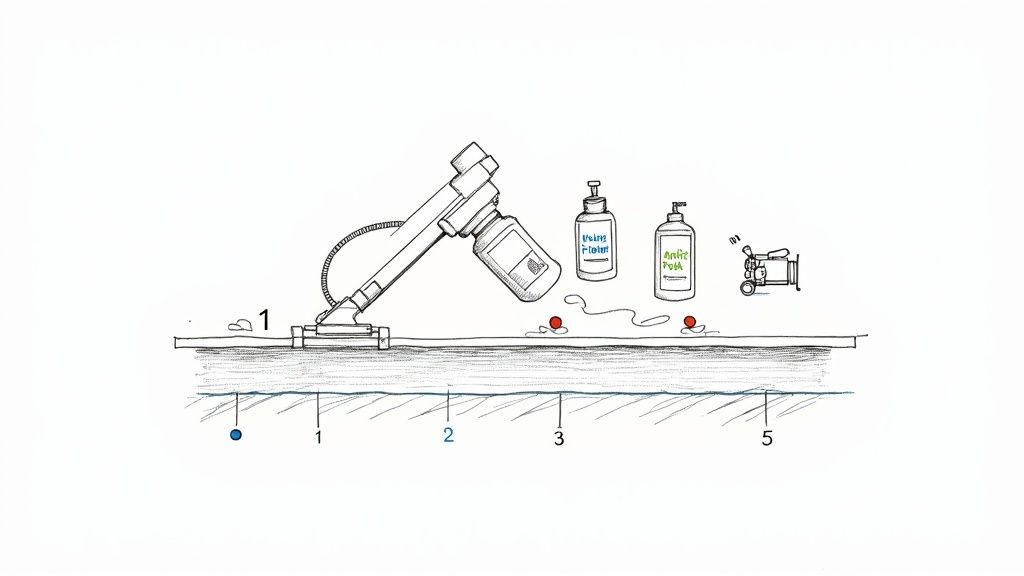Picking the right cleaning solution for your carpet machine is about more than just lifting stains—it’s about protecting the machine itself. The best carpet cleaning solutions for machines are always low-foaming formulas, ideally the ones recommended by your machine's manufacturer. Why? Because they're engineered to clean deeply without harming the sensitive internal parts, like motors and pumps.
Pouring the wrong stuff in, especially a homemade concoction, can create a mountain of suds, leave a sticky residue on your carpets, and might even void your warranty.
Navigating Your Carpet Cleaning Solution Choices
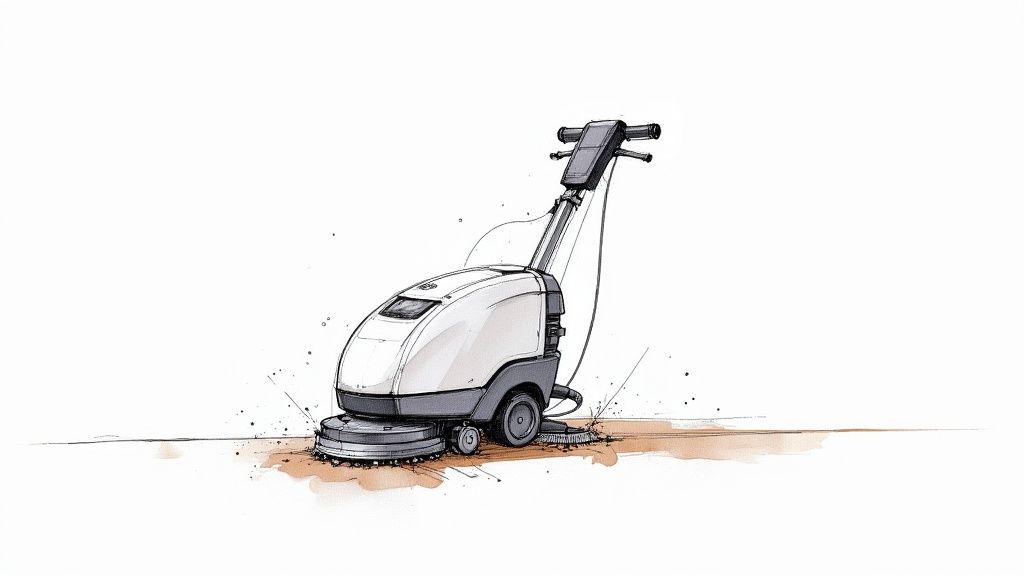
Think of your carpet cleaner like a car engine. You wouldn't put diesel in a petrol car, and for the same reason, you shouldn't pour just any old soap into your machine. The wrong formula can set off a chain reaction of problems, turning a simple cleaning day into a weekend-ruining, expensive repair. Getting your head around the basics is the first step to getting that professional-level clean while keeping your machine in good nick.
The whole setup—the machine, the solution, and your carpet—is a system designed to work together. The right liquid is formulated to work with the machine's specific water pressure, heat output, and suction power. It's this teamwork that really gets down into the carpet fibres and pulls out all that ground-in dirt.
The Myth of "Any Soap Will Do"
It’s a common mistake to think that regular household soaps, like washing-up liquid or laundry detergent, are a good substitute. They might produce a lot of impressive-looking foam, but that’s exactly where the trouble starts. Carpet cleaning machines simply aren’t designed to cope with that many suds.
All that foam can easily overwhelm the recovery tank and get sucked straight into the vacuum motor. Once moisture gets into those delicate electrical components, it's game over. You're looking at motor failure, which is almost always a costly fix not covered by the warranty.
Using a non-approved, high-foaming detergent is one of the fastest ways to kill a carpet cleaning machine. The suds can cause irreversible damage to the motor, and the sticky residue they leave behind acts like a magnet for fresh dirt, making your carpets look grubby again in no time.
Key Factors for Selecting the Right Solution
Before you grab any bottle off the shelf, think about these three crucial points. Getting this right ensures you get a great clean without causing any damage.
- Your Machine's Model: First things first, check what the manufacturer recommends. Brands like Vax, Bissell, and Rug Doctor spend a lot of time developing their own formulas that are guaranteed to work safely and effectively in their machines. Your user manual is the best place to start.
- Your Carpet's Material: Not all carpets are created equal. Tough synthetic fibres can take a fair bit of punishment, but natural materials like wool are much more delicate. Wool is particularly sensitive to cleaners that are too alkaline or acidic, which can cause permanent damage or discolouration.
- The Type of Mess: A standard shampoo is fine for general, everyday dirt. But for specific stains, you need a specific tool for the job. If you’ve got pets, for example, an enzymatic cleaner is your best bet. It doesn't just clean the stain; it uses enzymes to break down the organic proteins causing the smell, eliminating it for good.
Making a smart choice here will keep both your carpet and your machine happy for years to come. For more expert advice on keeping your home looking its best, you can find a whole host of articles on our Signal Cleaning blog.
Why Machine-Specific Formulas Are Essential
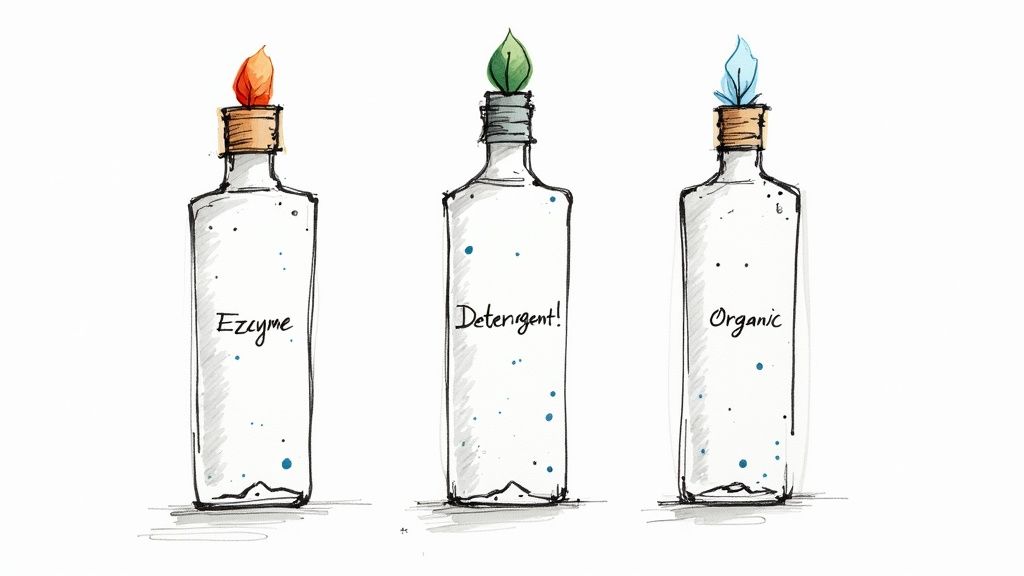
Think of your carpet cleaner as a high-performance engine. You wouldn't pour just any old fluid into a finely tuned car and expect it to run smoothly, and the same logic applies here. If you want a genuinely deep clean and want to protect your investment, using a formula specifically engineered for your machine isn't just a good idea—it’s essential.
Reaching for a generic or homemade solution might feel like a clever way to save a few quid, but it's often a false economy. It’s a bit like putting diesel into a petrol car; any short-term savings can be completely wiped out by long-term damage. The chemistry inside a bottle of proper carpet cleaning solution is a precise science, blended to work in perfect harmony with your machine's mechanics.
The Science of Synergy
A machine-specific formula is so much more than just fancy soap. Every single ingredient has been chosen to interact perfectly with your machine’s heat, water pressure, and suction power. This teamwork between the chemical and the machine creates a cleaning action that standard detergents just can't touch.
The result is a far deeper, more effective clean that lifts grime right from the base of the carpet fibres without leaving behind any gunk or residue. It’s a beautifully coordinated effort between chemistry and mechanics.
Let's break down what makes these formulas so crucial:
- Precise pH Balance: This is key to preventing damage to delicate carpet fibres. A solution that’s too acidic or alkaline can cause discolouration, weaken the fibres, or even dissolve the latex backing holding your carpet together.
- Low-Foaming Agents: This might be the most critical point of all. Too many suds can get sucked into the machine's motor, causing catastrophic failure and almost certainly voiding your warranty.
- Anti-Resoiling Polymers: These clever ingredients leave an invisible shield on your carpet fibres, which helps to repel future dirt. It means your carpets stay looking fresh for much, much longer.
"The true value of a machine-specific solution lies in its ability to clean effectively while protecting the intricate components of the cleaner. It’s an engineered partnership between the liquid and the machine, ensuring both longevity and superior results."
Avoiding Damage and Getting the Best Results
Using an unapproved cleaner is asking for trouble. The most common problem is the sticky residue that high-foaming detergents leave behind. This tacky film acts like a magnet for new dirt, which means your freshly cleaned carpets get grubby again in a fraction of the time.
Beyond that, the wrong chemicals can react badly with your machine's internal plastic and rubber parts, like the seals and hoses. Over time, they can become brittle and crack, leading to leaks and a loss of suction power that makes the machine pretty useless.
More and more of us are looking for professional-grade cleaning results at home. In the UK, the wider cleaning services market was valued at nearly £60 billion in 2021, and carpet cleaning is a huge part of that. Global revenues are projected to climb from around USD 3.99 billion in 2022 to nearly USD 5.98 billion by 2030, showing just how much we've all embraced effective, machine-based cleaning. You can discover more about the UK cleaning industry's growth and see what it means for homeowners.
Why Manufacturer Formulas Matter
Brands like Bissell, Vax, and Rug Doctor spend a fortune on research and development, creating formulas that are perfectly calibrated for their machines. When you use their recommended solution, you're not just buying a cleaner; you're using a product that has been tested again and again to deliver the best possible performance.
This gives you a few key benefits:
- Guaranteed Compatibility: You have peace of mind that the solution won't harm any of the machine's internal parts.
- Maximum Cleaning Power: The formula is designed to get the absolute most out of your machine's specific features, tackling stains and dirt effectively.
- Warranty Protection: Using the approved formula means you won't accidentally do something to void your manufacturer's warranty.
At the end of the day, sticking to machine-specific formulas is the smartest move for anyone serious about looking after their carpets and their cleaning equipment. It's the only way to guarantee a safe, deep, and long-lasting clean every time.
Breaking Down Common Cleaning Solution Types
Staring at an aisle full of carpet cleaning formulas can feel overwhelming. It’s easy to just grab the first bottle you see, but taking a moment to understand what's inside can be the difference between a so-so clean and a fantastic one. Think of these solutions like a specialist’s toolkit – you need the right tool for the right job.
Each type of carpet cleaning solution for machines is engineered to tackle a specific kind of mess. Using a general cleaner on a stubborn pet stain is like using a butter knife to chop an onion; it might work eventually, but it’s not the most effective way. Matching the formula to the problem saves you time, effort, and delivers a much deeper, more satisfying clean.
Enzymatic Cleaners: The Stain Demolition Crew
If you’ve got pets or kids, enzymatic cleaners are nothing short of a lifesaver. These aren't your typical soaps. Instead, they’re packed with beneficial enzymes—think of them as a microscopic demolition crew that gets to work on organic messes.
When you use an enzymatic solution on a stain from pet urine, spilt milk, or food, the enzymes target and break down the specific proteins, starches, and fats making up the mess. They don't just lift the visible part; they completely dismantle the stain at a molecular level. This is absolutely crucial for getting rid of nasty odours for good.
Here's why they're so effective:
- Targeted Action: The enzymes are programmed to go after organic stuff, breaking it into tiny, water-soluble bits your machine can easily suck up.
- Odour Elimination: By destroying the source of the smell, they stop those lingering odours that have a nasty habit of reappearing on damp days.
- Gentle on Fibres: Most are pH-neutral, making them a safe bet for a huge range of carpet types, including delicate natural fibres.
Oxygen-Based Cleaners: The Brightening Powerhouses
Ever spilt a glass of red wine or a mug of black coffee and felt that sense of dread? This is where oxygen-based cleaners come to the rescue. These formulas harness the power of active oxygen to break down and lift away those vibrant, dye-based stains.
When the solution mixes with water, it releases a flurry of tiny oxygen bubbles. This reaction, known as oxidation, attacks the chemical bonds of the stain, effectively bleaching out the colour without harming your carpet’s original dye. It’s a brilliant way to deal with colourful disasters.
Think of it as a gentle, colour-safe bleach for your carpet. It doesn't just remove the stain; it actually brightens the fibres, leaving your carpet looking refreshed and vibrant, not faded.
This type of cleaner should be your go-to for any intensely coloured spill. It works wonders on fruit juice, tea, and all those other common household accidents that leave a glaring mark.
The image below gives a great visual of how choosing the right solution can make a real difference in how quickly you see results.
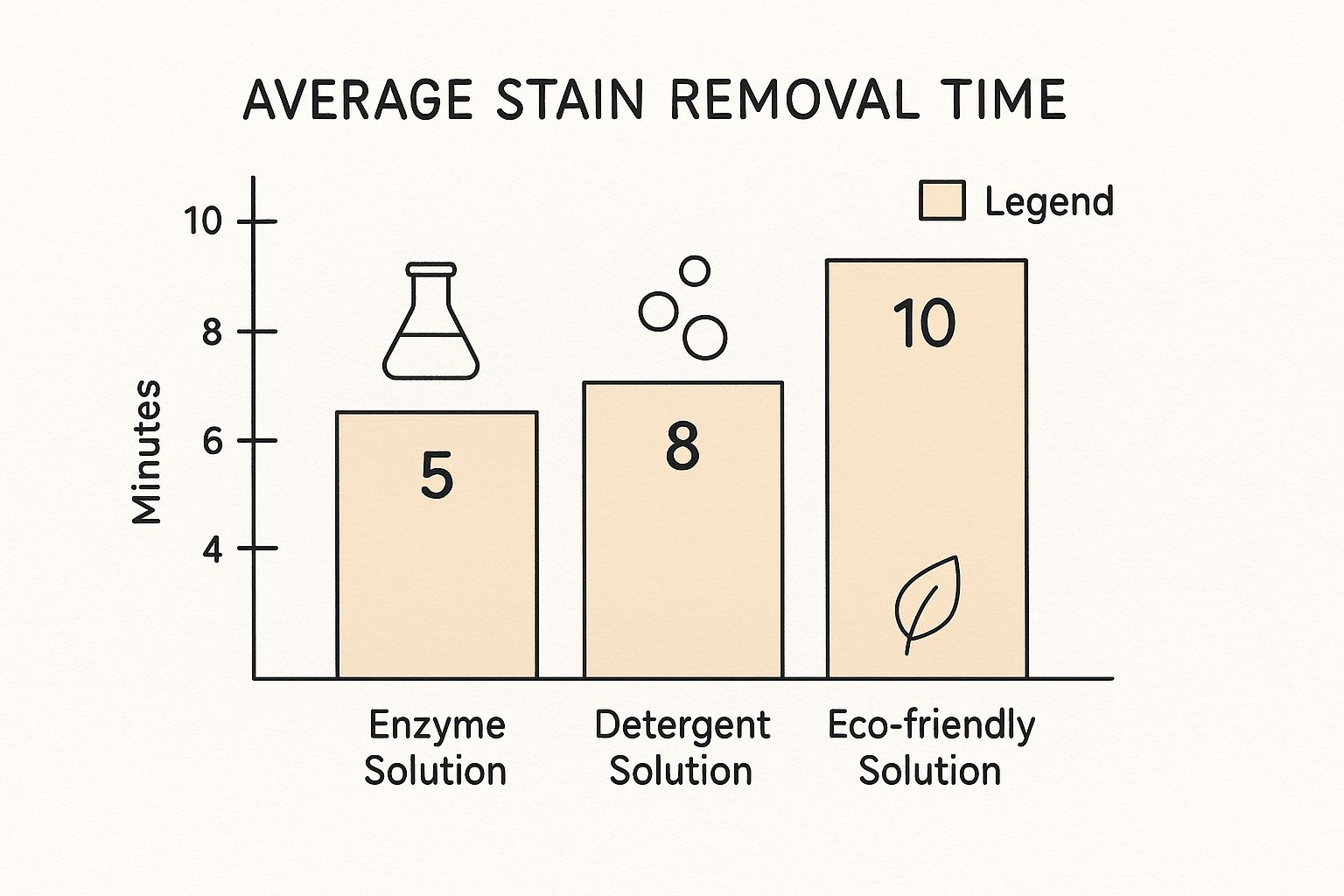
As you can see, specialised formulas like enzymatic solutions often cut down the cleaning time significantly when used on the right kind of stain, compared to just a standard detergent.
At-a-Glance Guide to Carpet Cleaner Solutions
To make choosing a little easier, this table breaks down the main types of cleaning solutions, what they do best, and which carpets they're suited for.
| Solution Type | Primary Function | Best For Tackling | Carpet Compatibility |
|---|---|---|---|
| Enzymatic Cleaner | Breaks down organic matter | Pet urine, food spills, vomit, blood | Excellent for most synthetic and natural fibres (always patch test) |
| Oxygen-Based Cleaner | Lifts and decolourises stains | Red wine, coffee, tea, fruit juice | Best for synthetic carpets; use with caution on wool/natural fibres |
| Pre-Treatment Spray | Loosens deep-set dirt | High-traffic areas, ground-in grime | Generally safe for all machine-washable carpets |
| Rinse Aid / Neutraliser | Removes detergent residue | Post-cleaning stiffness, dullness | Highly recommended for all carpet types to restore softness |
Using this as a quick reference can help you confidently pick the perfect product for your specific cleaning needs.
Pre-Treatments and Rinse Aids: The Finishing Touches
To get a truly professional-level result, you need to think beyond just the main cleaning formula. Two other products can make a huge difference: pre-treatment sprays and rinse aids.
A pre-treatment spray is your first line of attack against those really tough spots. You spray it directly onto high-traffic lanes or set-in stains about 5-10 minutes before you start cleaning. This gives the concentrated formula time to work its way deep into the carpet fibres, loosening the dirt and making it much easier for your machine to lift away.
A rinse aid (sometimes called a neutralising rinse) is the final, crucial step for getting that soft, fresh-from-the-shop feel. Some cleaning detergents can leave a slightly sticky residue behind, which makes the carpet feel stiff and actually attracts new dirt faster. A rinse aid is a mild, acidic solution you add to the final rinse water. It neutralises any alkaline soap residue left in the fibres.
This simple step leaves your carpets feeling noticeably softer and helps them stay cleaner for longer. It’s an optional touch, but one I always recommend for the best possible finish.
Understanding What's Inside Your Cleaning Solution
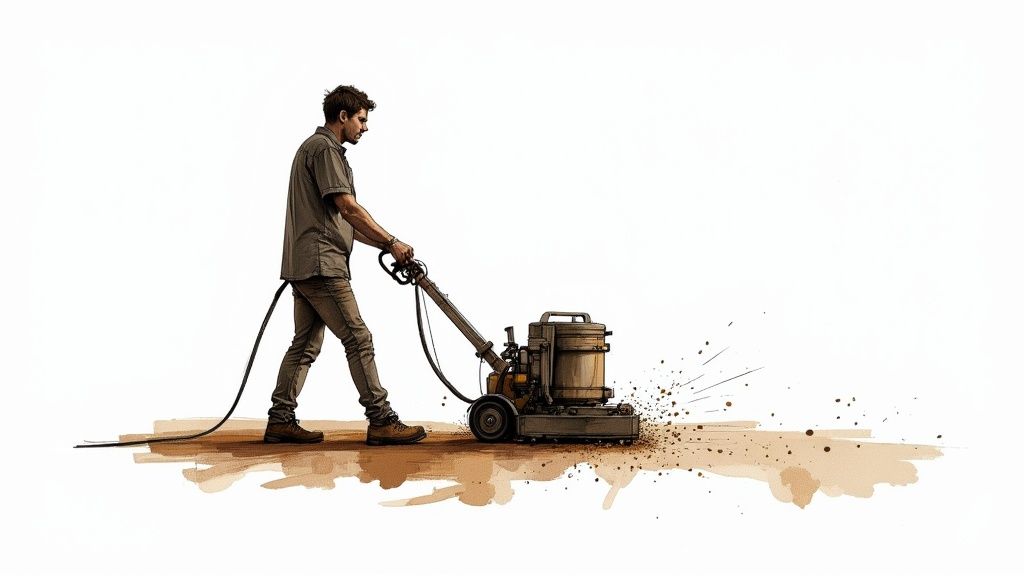
Have you ever found yourself in the cleaning aisle, staring at a bottle of carpet cleaner and feeling like you need a degree in chemistry to figure out what's on the label? You're definitely not alone. The list of ingredients can be pretty baffling, but getting to know what’s actually in the formula is the secret to getting a fantastic clean without accidentally damaging your carpet.
Think of it like a good recipe. Each ingredient has a very specific job to do, and they all have to work in harmony to break down dirt, lift out stains, and leave your carpets feeling genuinely fresh. Once you know the main players, you can pick out carpet cleaning solutions for machines like a pro.
The Power Players: Surfactants and Solvents
At the heart of any decent cleaning solution, you'll find two heavy lifters: surfactants and solvents. They're a dynamic duo, each tackling different kinds of grime to make sure you get a deep clean, right from the base of the fibres to the very tips.
Surfactants are the real workhorses here. Picture a tiny molecule that’s a bit like a magnet – one end loves water, and the other end loves oil and dirt. When you're cleaning, these little guys grab onto the dirt particles, pulling them away from the carpet fibres so the machine's water can easily wash them away.
Solvents, on the other hand, are the specialists. They're designed to dissolve all the greasy, oily messes that water simply can't handle on its own. They’re essential for getting rid of things like food spills, greasy footprints, or oily residues that get trodden in from outside.
Ingredients to Approach with Caution
Just as it's important to know what you want in a solution, it's crucial to know what you want to avoid. Certain chemicals can end up doing more harm than good, leading to permanent damage or odd discolouration over time. Being a savvy buyer means keeping an eye out for a few red flags on that ingredients list.
Here are a few ingredients you should be wary of:
- Optical Brighteners: These don't actually clean anything. Instead, they coat the carpet fibres with a substance that reflects blue light, making the carpet look brighter. The problem is, this coating builds up over time and can eventually cause a distinct yellowing effect that's a nightmare to get rid of.
- High-Alkaline Agents (High pH): While these can be effective on tough synthetic carpets, highly alkaline solutions are a disaster for natural fibres like wool. Wool is very sensitive to pH levels, and a harsh, alkaline formula can strip its natural lanolin, leaving it brittle, dull, and prone to damage.
- Perchloroethylene ("Perc"): This is a powerful solvent you might find in some heavy-duty spot removers. It’s a pretty harsh chemical that can release strong fumes, so it’s best left to the professionals and avoided for general cleaning around the house.
Always double-check the label for compatibility with your carpet type, especially if you have wool or wool-blend carpets. Using the wrong pH level is one of the most common and, unfortunately, irreversible cleaning mistakes people make.
The Rise of Eco-Friendly Formulas
Over the last few years, the demand for cleaning options that are both effective and kind to the planet has really taken off. Modern eco-friendly carpet cleaning solutions for machines are miles ahead of the weak, ineffective formulas of the past. Today's plant-based solutions pack a serious cleaning punch without relying on harsh chemicals.
These formulas generally use natural enzymes and plant-derived solvents to break down dirt and tackle stains. Better yet, they are often biodegradable and free from the synthetic fragrances, dyes, and other irritants found in traditional cleaners.
Choosing an eco-friendly option is a brilliant move for any home, but it's particularly important if you have small children or pets. Little ones and four-legged friends spend a lot of their time on the floor, so using a solution free from harsh chemical residues gives you real peace of mind. They prove you don't need aggressive chemicals to get fantastic results.
How to Match Solution to Carpet and Machine
Knowing the theory is one thing, but putting it into practice is where you’ll see the real results. Making sure your chosen carpet cleaning solution for machines is a perfect match for your carpet and your machine isn’t just a good idea—it’s the secret to a successful clean that protects both of your investments. Get this combination right, and you'll achieve that professional-level finish every single time.
This is more important than ever, especially when you consider how far carpet cleaning machines have come. The global market was valued at around USD 776.62 million in 2024 and is expected to hit USD 1.32 billion by 2033. That growth is fuelled by increasingly sophisticated machines with complex pumps, heaters, and vacuums designed to lift out the most stubborn dirt—a trend we're definitely seeing here in the UK. You can read more on the tech behind these machines and discover the full carpet cleaner market research.
Consider Your Machine Brand
Big names like Vax, Bissell, and Rug Doctor don't just sell machines; they pour a lot of time and money into developing their own cleaning formulas. Using their recommended solution is almost always the safest bet. It's been perfectly calibrated to work with that specific machine’s water pressure, temperature, and suction power. Go off-piste with an unapproved product, and you might not only get a poor result but could also end up voiding your warranty.
- Vax Machines: These generally work best with low-foaming solutions that are designed to complement their patented cleaning technologies.
- Bissell Cleaners: Bissell offers a huge range of formulas, including special pet and pro-level solutions, all created to work seamlessly with their Heatwave Technology.
- Rug Doctor Machines: Known for their powerful brushes, Rug Doctor solutions are made to handle vigorous scrubbing without turning your living room into a bubble bath.
Identify Your Carpet Material
Before you even think about pouring a cleaning solution, you need to know what your carpet is made of. Different fibres have wildly different needs and tolerances. A quick check now can save you from a complete cleaning disaster later.
Most carpets have a label on the back, but if that’s missing, a simple burn test on a few spare fibres can reveal a lot. Synthetics like nylon or polyester tend to melt and form a hard little bead. Natural fibres like wool, on the other hand, will char and give off a smell like burning hair.
Wool is probably the most sensitive carpet material you'll come across. It’s easily damaged by high-alkaline (high pH) cleaners, which can strip its natural oils, leaving the fibres brittle and dull. For wool, you must stick to a pH-neutral, wool-safe formula.
Perform a Crucial Spot Test
Whatever you do, don't skip this step. I don't care how confident you are in the product—a spot test is your final, critical safety check to prevent widespread discolouration or fibre damage. It takes five minutes but can save you from an expensive, irreversible mistake.
Here’s the right way to do it:
- Choose a Hidden Area: Find a spot that’s usually covered, like under the sofa, inside a wardrobe, or in a far corner of the room.
- Mix a Small Amount: Prepare a tiny bit of the cleaning solution, following the dilution instructions on the bottle.
- Apply and Blot: Using a clean, white cloth, apply a small amount to the carpet. Gently blot the area; don’t scrub it.
- Wait and Check: Let it dry completely. Once it’s dry, check for any colour bleeding, fading, or changes in the carpet’s texture. If everything looks exactly as it did before, you're good to go.
Concentrated vs Ready-To-Use Formulas
Your final choice is between concentrated and ready-to-use solutions. Concentrated formulas are often better for your wallet and the environment, as they use less packaging. The catch? You have to be precise with the dilution. Get the ratio wrong, and you could be left with a weak clean or a sticky residue that attracts more dirt.
Ready-to-use formulas offer pure convenience. You just pour them straight into the machine with no measuring or mixing, which is brilliant for quick jobs or small spills. The trade-off, of course, is a higher cost per clean. If you want to get a head start on specific blemishes before the main event, have a look at our guide on how to remove stubborn stains.
Frequently Asked Questions
When you're dealing with carpet cleaning machines and the various solutions that go with them, a few questions always seem to pop up. You want the best results, of course, but you also want to avoid accidentally damaging your machine or your carpet. Let's walk through some of the most common queries to help you clean with total confidence.
Think of this as a quick-reference guide to reinforce everything we've covered, making sure you're ready for whatever your carpets throw at you.
Can I Use a DIY Vinegar Solution in My Carpet Cleaner?
It's tempting to reach for household staples like vinegar for a quick, cheap clean, but I'd strongly advise against using it in your carpet cleaning machine. While vinegar is a great natural cleaner for certain things, its acidic nature is bad news for the internal components of your machine. Over time, it can eat away at the rubber seals and delicate plastic parts, leading to leaks, poor suction, and a hefty repair bill.
On top of that, DIY solutions just don't perform as well. They don't have the low-foaming agents that professional formulas do, and they lack the anti-resoiling technology that stops dirt from sticking to the fibres later. You'll likely end up with a less effective clean and a sticky residue that makes your carpets get dirty even faster.
A quick heads-up: always check your machine’s warranty before you even think about using an unapproved cleaner. Using a homemade mix like vinegar is one of the most common ways people void their warranty, leaving them on the hook for any resulting damage.
How Much Solution Should I Actually Use?
This is one area where you absolutely need to follow the instructions to the letter. It’s a common myth that adding a bit of extra solution will give you a super-powered clean. In reality, it does the exact opposite. Using too much concentrate is the fastest way to leave a sticky, soapy film all over your carpet fibres.
This tacky residue not only makes your carpet feel stiff and look dull, but it also acts like a dirt magnet. You'll find your freshly cleaned carpet looks grubby again in no time. On the flip side, using too little solution just won't have the muscle to lift out that deep-down grime.
Always check two things:
- The dilution instructions printed on the solution bottle.
- The fill lines clearly marked on your machine’s water tank.
These guides are there for a reason—they're precisely calculated to give you the perfect water-to-solution ratio for maximum cleaning power without any sticky aftermath.
What Is a Pre-Treatment Spray and When Do I Need It?
Think of a pre-treatment spray as your secret weapon for targeted stain removal. The main shampoo that goes into your machine is for general, all-over cleaning. A pre-treatment, however, is a more potent, concentrated formula that you apply directly onto tough spots before you begin the main cleaning process.
You'll want to use it on specific problem areas like coffee spills, muddy paw prints, or that bit of dropped food. Just spray it directly onto the stain, let it work its magic for about 5-10 minutes, and then clean the area as normal with your machine. That 'dwell time' gives the powerful ingredients a chance to penetrate deep into the fibres and start breaking the stain down, making it far easier for your machine to lift it away for good. It's a non-negotiable step for a truly spotless finish.
Are Eco-Friendly Solutions as Powerful as Chemical Ones?
They certainly are. Modern eco-friendly formulas have advanced so much that they now give traditional chemical-based cleaners a serious run for their money. Instead of relying on harsh synthetic chemicals, they use powerful, plant-derived enzymes and solvents that are brilliant at breaking down dirt and stains naturally.
For the vast majority of household spills and organic stains you’ll encounter, a high-quality, plant-based formula will perform just as well as its chemical counterpart. The trick is to choose a reputable brand that has specifically formulated its eco-friendly carpet cleaning solutions for machines. They're a much safer choice, especially for homes with children, pets, or anyone with allergies.
When you decide it's time for a professional touch that guarantees incredible results, why not schedule a service with the experts? You can explore our services and get a quote on our professional carpet cleaning booking page.
